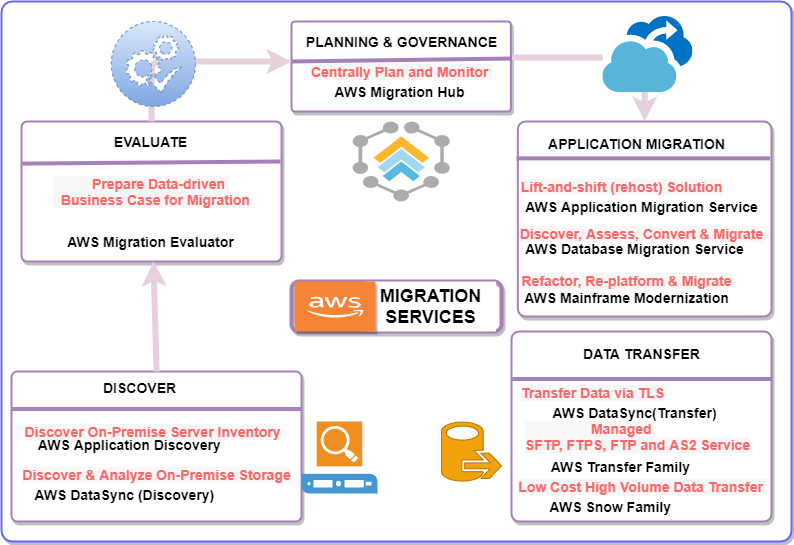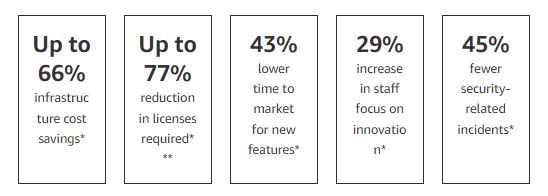AWS Cloud Migration Services in a Nutshell
AWS Migration Services offer a streamlined approach for businesses transitioning to the cloud.
It divides the whole migration process into logical steps like discovery, evaluate , plan and migrate for smooth, secure, and optimized migration to the cloud. The AWS cloud migration cheatsheet below shows the key services facilitating each of the imprtant steps.

1. The Nutshell View
The entire cloud migration process can be segregated into the following key steps :
Discovery: Discovery involves identifying existing applications, data, dependencies along with the key performance data such as the CPU, memory, disk usage as well as the network performance.
These details forms important ingredient for further evaluation , planning such as grouping applications, allocating proper resources etc.
Evaluation: Evaluation assesses each application's cloud readiness, considering performance, security, and compliance.
The main outcome this step is to prepare an initial business-case with possible migration options and cost-benefit analysis that aids the extensive planning, cost estimation and formulation of the right migration strategies.
Planning: Planning focuses on deciding on the migration strategies, designing the target architecture, selecting suitable AWS services, and estimating the costs.
Migrate: During Migration, data and applications are transferred. We can utilize services like:
- AWS Server Migration Service for virtual machines and
- Database Migration Service for databases.
Depending on the chosen migration strategy, we may need to consider the modernization and 3rd party service purchasing activities before the migration takes place.
Testing: It's an important step that ensures the success and readiness of the migration process including the important factors like the features, scalability, reliability and security.
Governance: Governance involves continuous management and monitoring of the migration process as well as the associated modernization activities.
7Rs of Cloud Migration Strategies
Each application has it's unique significance, own tech stack and a separate phase of life. Hence, these applications need a careful analysis for it's migration to cloud for optimal benefits.
Here, is a quick outline on the 7Rs of cloud migration strategies for planning our migrations:
(For more details with usage scenarios please refer the article : 7Rs of Cloud Migration Strategies)
Migrate with Minimal Changes:
- Relocate: Suitable for applications that are already cloud-ready and can be migrated without much change.
- Rehost: Rehosting, also known as "lift and shift". Suitable for applications that are not cloud-ready but, we want to migrate to cloud before we take up the long term modernization or repurchase plans.
- Re-platform: Suitable for applications that are not cloud-ready but that can be modernized with relatively minor changes.
Migrate with Major Changes:
- Refactor: Restructure and migrate the applications to optimize them for cloud environments, often using microservices, serverless or other modernizing options.
- Repurchase: Replace existing software with a cloud-based alternative as part of being cloud-ready or modernization.
Do Not Migrate to Cloud
- Retire: This is a strategy to identify and eliminate redundant, obsolete applications.
- Retain: Keep certain applications on-premise due to regulatory or technical constraints.
Here is a screenshot from AWS Website on Cloud Migration which list these benefits based on the experience of its 1000's of organizations who migrated to the cloud.

2. Brief Descriptions, Features & Usages of the AWS Cloud Migration Services
| AWS Service | Objective | Sample Usages |
|---|---|---|
| Plan & Evaluate | ||
| AWS Migration Hub | Centrally plan and monitor your migration. Provides a central location to collect server and application inventory data for the assessment, planning, and tracking of migrations to AWS. Migration Hub can also help accelerate application modernization following migration. | Discover or import your on-premises server details : AWS Discovery Agent or AWS Discovery Collector can help you here. Build a migration plan : Vizualize you servers, their groupings, roles and dependencies using Migration Hub visualization. Strategy recommendations: Hub can analyze and recommend the optimal strategy and tools to migrate and modernize. Get Orchestration Templates: Speedup your migration using pre-defined templates, workflows and automated steps. Intuitive migration dashboard : Use it for tracking your migration. Incremental app refactoring : Hub can help you in further modernization beyond migration. Multi-region migrations: Supports planning and tracking of multi-region migrations. |
| Discovery & Assessment | ||
| AWS Application Discovery Service | Discover On-Premise Server Inventory. Discover the on-premise server inventories, their grouping and dependencies for planning. The discovery includes key performance data such as the CPU, memory, disk usage as well as the network performance. | Enables us to capture the detailed insights of our exsisting data centers, so that we can plan our cloud migrations better. The output of this service can be fed into services like : - AWS Migration Hub , - AWS Migration Evaluator or - AWS Database Migration Service for futher planning and execution. |
| Migration Evaluator | Create data-driven business case for cloud migration. The evaluation process broarly includes : 1. Collecting or importing datacenter inventory data. 2. Analyzing the data using Quick Insights. 3. Generating a evaluation report including cost and savings. | A business case report of the migration assessment includes: 1. List of inventory assessment taken as input. 2. Summary of the scenario based savings across different workloads. 3. Breakdown of the on-premises cost factors. 4. Multiple workload specific 'what-if' scenario analysis. 5. Recommendation for a successful migration. |
| Application Migration | ||
| AWS Application Migration Service (MGN) | Highly automated lift-and-shift (rehost) solution. - MGN Service automatically replicates entire servers, including OS, applications, data, and configurations. - Group your related applications and servers. Monitor execute and monitor their status. | - Use it lift-and-shift your applications, databases and enterprise applications such as Microsoft SQL Server, Oracle, and SAP. We can use it for : - Cross Cloud Migration - Cross-Region Migration or - Data Center to Cloud Migration. |
| AWS Database Migration Service(DMS) | Discover, Assess, Convert and Migrate your databases and analytics workload. The key steps involved in the process are : - Discover & Assess : DMS Fleet Advisor automatically lists and assesses your server fleets. - Convert : DMS Schema Conversion the source schema and code to match the target database. - Migrate : DMS creates a task to connect source and target database and initiates the migration. | - DMW supports both homogeneous and hetrogeneous database migrations. - Includes 20 plus database and analytics engines under it's support. |
| AWS Mainframe Modernization | Assess, modernize, migrate and run mainframe workloads in AWS cloud. | Assess: The assessment capability of the service can help you assess, scope, and plan a migration and modernization project. Refactor: We can use AWS Blu Age, to refactor legacy application into microservices, modern UI and application software stacks. Replatform: With Micro Focus Enterprise solution, we can port the application where much of the application source code is recompiled without changes. |
| Data Transfer | ||
| AWS DataSync | Discover, Plan & Migrate On-Premise Data AWS DataSync is an online data movement and data discovery service that simplify your data migration from you on-premise datacenters to AWS. Provides visibility into your on-premises storage performance and utilization, and provides recommendations on AWS Storage services for your data migration. | AWS DataSync Discovery: It can collect data about your storage system along with performance, capacity, and utilization metrics. DataSync Console: It provides a dashboards where we can analyze the discovery outcome to produce recommendations for migrating to AWS Storage services such as Amazon FSx for NetApp ONTAP, Amazon FSx for Windows File Server, and Amazon EFS. AWS DataSync Transfer: We can use it transfer the data to the desired storage destination using features like bandwidth throttling, migration scheduling, task filtering and so on. Note: We can use DataSync to transfer data via TLS : - Between On-Premise and AWS Cloud Storage -Between AWS and Other Cloud Storage and - Between two AWS Storage. |
| AWS Transfer Family | Fully managed SFTP, FTPS, FTP, and AS2 service Seamlessly migrate, automate, and monitor your file transfer workflows into and out of Amazon S3 and Amazon EFS using the SFTP, FTPS, and FTP protocols. | Some sample use cases for Transfer Family usage : - Copy data at scale between remote SFTP servers and Amazon S3. - Use AS2 protocol to reliably exchange B2B data with your trading partners. - Use built-in PGP step to trasfer sensitive data with encryption on transit. |
| AWS Snowball | Low-Cost, High Volume Data Transfer & Edge Computing AWS Snowball service provides an edge computing and data transfer device known as AWS Snowball Edge. AWS Snowball is available in two device types : - Snowball Edge Compute Optimized and - Snowball Edge Storage Optimized. | Supports cost effective high volume(80TB or 210TB) data transfer in and out of AWS. Support local data processing and collection in disconnected environments such as ships, windmills, and remote factories. |